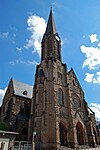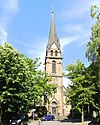List of architectural monuments in Friedrichsthal (Saar)
In the list of architectural monuments in Friedrichsthal , all architectural monuments of the Saarland city of Friedrichsthal and its districts Friedrichsthal, Bildstock and Maybach are listed. The basis is the sub-monuments list of the Saarbrücken regional association of the Saarland monuments list of December 16, 2013 and the current version.
Wayside shrine
| location | designation | description | image |
|---|---|---|---|
| Helenenstrasse 8 location |
Winding machine house at Shaft I of the Friedrichsthal mine | The hoisting machine house is a simple quarry stone building from 1860 and an early example of this type of construction. It is the only remaining building from the Friedrichsthal mine . | |
| Hofstrasse 44 location |
Legal protection room | The legal protection hall was built in 1891/92 by Heinrich Güth as a club for the “legal protection association for the mining population”. The elongated brick building was converted in 1985 for training and residential purposes. |

|
| Illinger Strasse location |
Wayside shrine tunnel | The 336 m long tunnel on the route between Saarbrücken and Neunkirchen consists of a 9.34 m wide tube made of 281 support rings. The new building had become necessary in the 1950s due to the sinking of the pits in the area of the old tunnel. | |
| Illinger Strasse location |
Winding machine house for shaft II of the Erkershöhe shaft | The shaft system included four shafts that were sunk between 1872 and 1885. In 1922 the production was stopped. The preserved hoisting machine house for shaft II of the Erkershöhe shaft was built between 1872 and 1876. | |
| Illinger Strasse location |
Headframe of the Erkershöhe mine with hoisting machine | The Erkershöhe pit is the last still existing headframe in Friedrichsthal. Shafts I and II were initially used as conveyor shafts, and later on extending weather shafts and pump shafts. The preserved headframe from shaft II was moved here from the Maybach mine (Frieda shaft) in 1960 |

|
| Illinger Strasse (opposite No. 1) location |
Virgin Mary statue | The Marian column in the wayside shrine was built in 1954 based on a design by the Saarbrücken artist Günther Maas. It originally stood on a green area at the rear of the market and was installed in the center of the square after it was renovated. | |
| Saarbrücker Straße 125/127 location |
Two-family house | The building was built in 1908 as a residence for officials of the Prussian mine administration. | |
| Saarbrücker Strasse 129/131 location |
Apartment building | The house was built in 1911/12 as a home for workers | |
| Spieser Strasse location |
Catholic parish church St. Josef | The Catholic church was built in the neo-Gothic style between 1905 and 1907 according to plans by the church builder Johann Adam Rüppel . During the renovation in the 2000s, elaborate ceiling and wall paintings were exposed and extensively restored. |

|
| To the Grühlingsstollen | The mouth of the entrance tunnel to the Helene shaft of the Friedrichsthal mine, around 1910/20 | The tunnel mouth can be recognized by an opening with a simple frame and was the entrance tunnel for the Helene II shaft. | |
| To the Grühlingsstollen location |
The opening in the Grühlings tunnel of the Friedrichsthal pit, 1856 | The tunnel mouth of the Grühlingsstollen is made of historic sandstone architecture with turrets and battlements. The bottom of the Grühlings tunnel served as the bottom for shafts I and II of the Friedrichsthal mine and was closed in 1927. During the Second World War it served as an air raid shelter. The architecture of the tunnel mouth was restored and greatly expanded around 1983. |

|
| To the Grühlingsstollen 2 position |
Administration building | The building with a central elevation was the seat of the mining inspection IX Friedrichsthal / Quiigart and was built in 1868. |
Friedrichsthal
| location | designation | description | image |
|---|---|---|---|
| Location at the train station |
Station reception building | The main building with two lower side wings was rebuilt in 1910 after the old station had to make way for track extensions. The building is now unused and only serves as a passage to the railroad tracks. |

|
| Bismarckstrasse location |
Evangelical parish church | The church was built between 1895 and 1897 according to plans by the architect Heinrich Güth in the neo-Gothic style. The rectangular hall with a small transept and a five-sided, polygonal choir is spanned by a wooden barrel vault. |

|
| Huettenstrasse location |
Catholic parish church Seven Sorrows of Mary | The church was built in 1927/28 according to plans by the Trier architect Peter Marx . A special feature was the free-standing bell tower, which was built in 1956 according to plans by the architect Fritz Thoma and had to be demolished in 2016 due to its dilapidation. |

|
| Saarbrücker Straße 38 location |
Residential and commercial building | The residential and commercial building on Saarbrücker Straße was built around 1905 according to plans by August Brenk . | |
| Schmidtbornstrasse 12a location |
secondary school | Today's town hall was built in 1906/07 as a secondary school. The school was closed in 1917 and has served as the seat of the municipal administration since 1919. |

|
Maybach
| location | designation | description | image |
|---|---|---|---|
| At the Albertschacht location |
The mine and the Maybach housing complex | The monument ensemble of the Maybach mine with the settlement is one of the most important mining ensembles in the Saarland. Of the daytime facilities of the pit, only the three hoisting machine houses built on different levels on the slope and the colliery house have been preserved. The former pit canteen has also been preserved. The importance of the almost completely preserved miners' settlement with church is described as outstanding. | |
| At the Albertschacht, memorial for crashed miners, 1930 (individual monument) | |||
| Colliery house, around 1900 (individual monument) | |||
| Winding machine house III (Frieda), around 1900 (individual monument) |

|
||
| Winding machine house II (Albert), 1882 (individual monument) |

|
||
| Winding machine house I (Marie), 1889 (individual monument) |

|
||
| Coffee kitchen of the Maybach mine settlement with convenience store, restaurant, 1897, extension 1936 (individual monument) |

|
||
| Hauerstraße 2/4/6, workers' house, 1910 (part of the ensemble) | |||
| Hauerstrasse 12, dormitory , 1910-1911 (Single Site) | |||
| Quierschieder Straße 1 / 2-19 / 20, twin houses for workers, 1901–1905 (part of the ensemble) | |||
| Quierschieder Straße 21, school of the Maybach mine settlement, 1905 (part of the ensemble) | |||
| Quierschieder Straße 22 / 24–58 / 60 (even numbers), twin houses for civil servants with separate farm buildings, 1884–1924 (part of the ensemble) | |||
| Quierschieder Straße 23 / 25–53 / 55 (odd numbers), twin houses for civil servants with separate farm buildings, 1884–1924 (part of the ensemble) | |||
| St. Barbarastraße 2 / 4-6 / 8, twin houses for civil servants, 1924 (part of the ensemble) | |||
| St. Barbarastraße 11/13, double house for civil servants, around 1900 (part of the ensemble) | |||
| St. Barbarastraße 15, residential building for civil servants, around 1900 (part of the ensemble) | |||
| St. Barbarastraße 24 / 26-28 / 30, twin houses for civil servants, around 1900 (part of the ensemble) | |||
| Stollenstraße 1, Villa, 1920 (part of the ensemble) | |||
| Stollenstraße 3, Villa, 1920 (part of the ensemble) | |||
| Kath. Filialkirche St. Ludwig (individual monument): The broken stone church was built in the form of a basilica in neo-Romanesque style. The church was built by the French mine administration at the request of Catholic mining families. |

|
||
| Ostschachtstrasse location |
Ensemble of the Maybach-Ost mine | The east shaft of the Maybach mine is considered to be an example of high architectural quality and the few examples of the use of Art Nouveau elements in mining facilities in Germany. the preserved daytime facilities were built in 1907, except for the boiler house. | |
| Boiler house, around 1900 (part of the ensemble) | |||
| Zechenhaus, 1907 (single monument) | |||
| Schachthalle, 1907 (individual monument) | |||
| Winding machine house, Maybach-Ost, 1907 (individual monument) | |||
Web links
Commons : Baudenkmäler in Friedrichsthal (Saar) - Collection of images, videos and audio files
- List of monuments of the Saarland: List of sub-monuments Regional Association Saarbrücken (PDF file; 1.67 MB)
Individual evidence
- ^ Gruben Friedrichsthal and Maybach , memotransfront
- ↑ Monuments of coal mining in Saarland ( Memento from August 12, 2011 in the Internet Archive ), Saarland State Monument Office